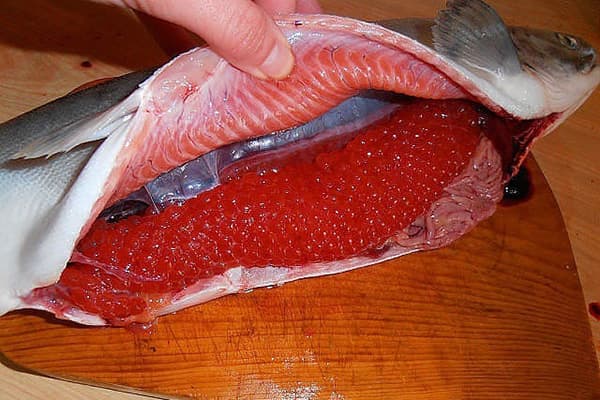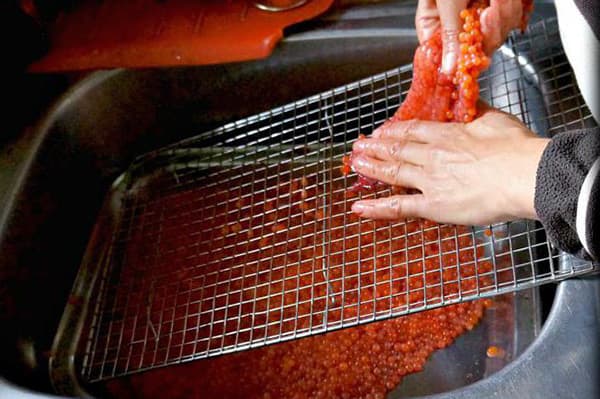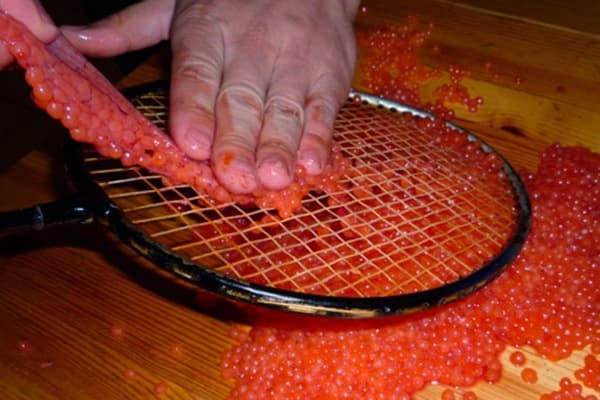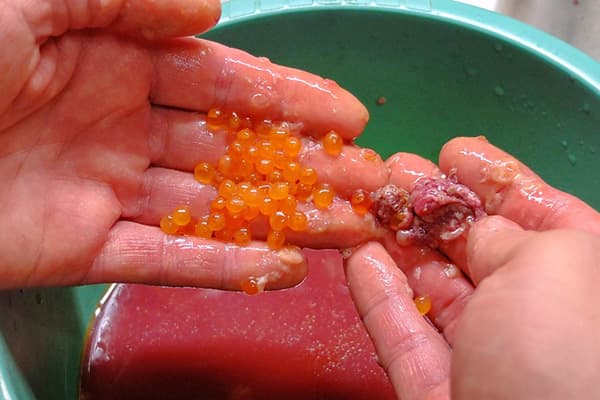Cut up the pink salmon, remove the caviar and prepare it for salting - now we’ll tell you how!
The modern seafood retail market has long stepped forward compared to even the last decade, and now in a regular supermarket it is not difficult to purchase good pink salmon or other noble fish, almost freshly caught. It’s especially nice when, as a result of such “shopping fishing,” you get a fish with caviar. However, the inexperienced “fisherman” has a question: how to clean the caviar from the film? How to prepare it for subsequent salting?
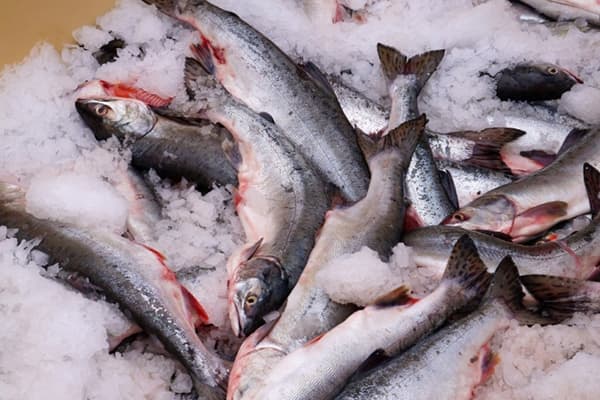
Choosing fish in the store
The first step is to choose a good “catching sample”. Here are the 5 main signs of a suitable specimen:
- The fish, of course, must have an obvious sign of the presence of caviar: a noticeably thick “belly”.
- Pay attention to the eyes - in good fish they will be transparent both fresh and frozen.
- Of course, the fish should not emit an unpleasant pungent odor, but it should smell, one might say, of the sea.
- If you take a fresh carcass, then pressing on its side should quickly remove the dent. In other words, the fish should be quite elastic.
- Another important sign of a quality product is red, loose gills.
Removing caviar from the carcass
So, your pink salmon has successfully made its way from the store counter to the kitchen. Where to begin?
- If you took frozen fish, then let it defrost completely, but do not keep it at room temperature.A carcass weighing a couple of kilograms will defrost for 3–5 hours at normal temperature - after which even slightly frozen fish can begin to be cut.
- First you need to rip open the belly of the pink salmon, starting from the head and ending with the anus. Do not dig the knife too deep so as not to damage the section with caviar and insides and not to stain everything with blood.
- Then, using the same knife, we slightly separate the caviar from the side walls by simply inserting the knife between the wall and the bag of caviar and slightly bending it to the side. This procedure must be done on both sides of the bag.
- Now you should separate the bags of caviar and entrails from the fish carcass. The bag and entrails are located quite tightly and are attached to the carcass in two places: next to the anus and near the head. Feel the attachment points with your fingers and separate them either with a knife or with gentle finger movements. This comes out quite easily.
The bag with pink salmon caviar is actually two independent bags, between which all the other insides of the fish are located.
- Carefully separate the caviar from the entrails. They are not tightly connected to each other, but the slippery surface, especially of a fresh carcass, can somewhat complicate the process of separating the caviar. Be careful and don't rush.
Separating caviar from film: two ways
The first method involves using a special sieve with large cells:
- The separated bags of caviar must be carefully ripped open using your fingers.
- Next, we arm ourselves with a tall glass, where we place the ripped bags of caviar.
- We insert a sushi stick into the glass and quickly move it in a circular motion along the caviar with the film. The film will gradually wrap around the tip of the stick.For best results, it is recommended to alternate the direction of movement of the stick.
- Then we take a sieve with round holes, which will be slightly larger in size than the eggs. Place the contents of the glass in a sieve and rub the eggs through the sieve with the palm of your hand, freeing them from any remaining film.
- We also put the film that is wound on a wooden stick into a sieve and, using the same movements with the palm of our hand, remove the remaining eggs from it.
Don’t be afraid to separate the caviar from the film in this way: the eggs of any red fish - pink salmon, trout or salmon - when fresh are quite elastic and will easily pass through a sieve without bursting.
If there is no special sieve, some homemade caviar lovers recommend using a badminton racket instead.

The second method of separating caviar from the film will appeal to those who trust heat treatment to avoid the appearance of parasites in products.
- After separating the bags of eggs from the fish and entrails, place them in a sieve with small holes - for example, the one through which flour is usually sifted - and boil water.
- We place the sieve on a deep bowl and pour boiling water over the caviar with film in small portions, stirring it immediately with a fork or spoon. It is important to spray with hot water in those places where you see the appearance of a curled film. Stirring quickly and intensively is also important: this way the eggs will not cook, will not burst and will remain intact, and the hot water will quickly drain through the sieve into the bowl.
In 3-4 passes you can scald almost all the film that was on the caviar and remove it with a fork.
Salting caviar
That's all! As you can see, there is not much hassle with caviar, and the work does not require a lot of time.In this sense, red fish can be an excellent “springboard” for getting your feet wet in the business of preparing fish caviar at home, so that you can then move on to more complex cases - for example, pike caviar.
Salting is a completely simple process. Typically, about 1–1.5 teaspoons of coarse salt are used for 200 grams of caviar.
To make sure that there is not too much salt and not too little, you can taste the caviar with salt right during salting.
We transfer the salted product into gauze, collect it in a bag and hang it over a small tray for about an hour to remove excess moisture.
Bon appetit!
